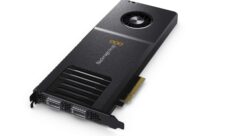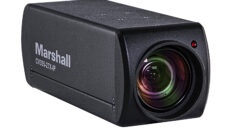

There was a time when a conference call was kind of a big deal. We were excited by the Jetsonesque notion of sitting at a table and discussing important business with people scattered across the globe. Excitement also arose from the relatively infrequent occurrence of conference calls, a primary reason for which was the fact that most offices had only one conference room with all the technology necessary to make them happen. At first this room had a conference table with a gooseneck mic at each seat and speakers on the walls. Then the mics and speakers disappeared into the background, and a video display and camera appeared. As conference calls became more indispensable, sleek plastic devices began to appear on tables in places other than the conference room, increasing the frequency of the calls, but alas, the devices were not all compatible with all the various types of calls. Smart manufacturers like Revolabs have recognized the demand for tabletop conferencing devices that are capable of handling more than one type of conference call, and now a BYOD (bring your own device) conference call can happen spontaneously, held almost anywhere. I evaluated a Revolabs FLX UC 1000 recently and was pleased to discover how far we’ve come in the development of teleconferencing technology.
The FLX UC line from Revolabs comprises three packages: the FLX UC 500, which is a sophisticated USB conference phone; the FLX UC 1000 consists of a VoIP phone and a dialer unit; and the FLX UC 1500 adds to the FLX UC 1000 a pair of directional extension microphones to enhance audio quality. The FLX UC 1000 that I evaluated included the conference phone, the dialer unit, a 2-meter USB cable, and a 25ft. Ethernet cable. The main phone unit is a 5in. cube. Its outside is formed primarily of black plastic with an attractive matte finish and rounded corners. At the top is a metal grille protecting the unit’s two speakers, a tweeter and “mid-woofer.” I was initially skeptical about the seemingly strained designation of the low-frequency driver, but when I heard its output, I think the term “mid-woofer” is accurate. It doesn’t pour out table-shaking bass, but it’s adequate for clear reproduction of the human voice. It’s not full-on midrange; it’s not full-on woofer, so mid-woofer works.
The microphones are on each of the bottom corners. Together, they achieve a full 360 degree of pick-up. Above each mic is a status- indicating LED. On top of the enclosure, there are capacitive touch buttons in the upper right and lower left corners. There are answer and hang-up buttons on one corner, and volume up, down, and mute buttons on the corner diagonal. The case sits on seven rubber feet that prevent it from sliding around. There are three ports under the box: USB, Ethernet, and a proprietary RJ-11 jack to connect the system’s dialer unit. It’s not difficult to plug into the Ethernet port, but it’s a real challenge to dislodge the cable and pull it out. At the rear of the case is a Kensington security slot. This main phone unit is truly a beautiful design.
The square dialer unit is a touch smaller in width and length (5.2”x5.3”, respectively). It wedge-shaped, sloping upward from front to back, roughly .5in. tall at the front and a little more than 1.5in. at the back. The same FLX UC matte black surface frames a glossy control/ display surface with a large LCD screen, dial pad, and pushbuttons for navigation, level, mute, menu, redial, answer, hang-up, and four soft keys. An integrated cable connects to the RJ-11 communications port under the main VoIP unit.
The system connects via both USB and Ethernet, and once the connections are made, users can manage the system with any Internet browser by typing in the system’s IP address. Here, users can control numerous parameters, including security, lighting configuration, and deployment server settings. Ring-tones, equalization, filtering, and codecs are also determined via IP, as are messaging and voicemail settings, along with VLAN settings, time and date, and SIP and transport settings as well. A computer app is also available for both Mac and Windows platforms.
I connected the main VoIP unit to my Mac Pro and it dawned on me that I do not have a device that provides power over Ethernet (PoE). This system is only powered by PoE, which could be a bit of a problem for some users. It’s not as if PoE injectors or Ethernet switches that provide PoE are expensive or hard to find, especially considering that Revolabs makes a PoE adapter available. But in my mind, the expectation that a device like this would emerge from its box ready to go without the provision of a moderately esoteric power source is not a stretch. I drove down to the local electronics big box store and purchased a PoE injector for $25, brought it home, and hooked it up. Once I had the system connected and powered, the experience became a lot more pleasant.
I was able to designate the FLX UC 1000 as both audio input and output for my computer via the Mac OS Audio MIDI Setup application, and once that was accomplished, the system’s audio input and output was available to every application on the computer, not just softphone apps. Moreover, the audio can be split off to audio apps to provide a way to record conference calls. The same can be accomplished on Windows systems with the appropriate drivers. But even without a computer, the system is quite sophisticated.
One of its principal strengths is the capacity to bridge IP calls with USB calls. This relates to the BYOD functionality. It allows you to conduct a conference call that connects between cities via traditional telephone, but within buildings, individuals can bridge in via softphone with the Revolabs system connected to a computer in an office, huddle room, or wherever. Gone are the days when call participants had to all gather in the one place in a building where the conferencing technology was located. Revolabs’ technology allows users to gather virtually anywhere (or not gather at all, as in the case of individuals joining the call from their own offices or other locations).
The FLX UC 1000 is a novel device that offers functionality that could almost be described as the democratization of teleconferencing. It truly opens up the possibilities. The operation of the device is simple for end-users once it’s been configured, and is not difficult to configure, for that matter. From a design standpoint, it’s very attractive and functional, with the one exception of the phone unit’s RJ-45 Ethernet port. The only other minor quibble is the fact that it can only be powered by PoE. I just can’t think of any other end-user device that requires an esoteric power supply but does not automatically include it with the package. Nevertheless, this is far from being a deal-breaker. As I stated before, PoE injectors or Ethernet switches that provide PoE are common and not expensive, and the functionality gained is worth jumping through that extra hoop. I’d definitely recommend the consideration of this product to any person or organization in need of a powerful, flexible tabletop conferencing solution.
John McJunkin is the founding manager of Avalon Podcasting, LLC, and produces video for a variety of clients. He has consulted in the development of studios and installations and provides high-quality podcast and voice-production services.
PRODUCT SUMMARY
COMPANY: Revolabs | www.revolabs.com
PRODUCT: FLX UC 1000 IP & USB Conference Phone
PROS: Easy to use, good quality audio, very flexible, bridges VoIP and USB calls
CONS: System can only be powered by PoE, RJ-45 jack in very awkward place
APPLICATIONS: Flexible phone conferencing for both IP and USB applications
PRICE: $799 (FLX UC 1000 IP & USB Conference Phone)
SPECIFICATIONS
CODECS: G.711, G.722, G.726, G.729
DTMF SUPPORT: RTP event, SIP in-band, SIP info package support
SPEAKER ELEMENTS: Tweeter, Mid-woofer
SPEAKER FREQUENCY RESPONSE: 160Hz – 20kHz
MAXIMUM SPL: 91dB @ 1M
MICROPHONE COVERAGE: 360º
MICROPHONE FREQUENCY RESPONSE: 160Hz – 12kHz
ECHO CANCELLATION: Individual AEC per microphone
FULL DUPLEX: Yes
POWER INTERFACE: PoE (Power over Ethernet)
USB: Mini USB 2.0 Connector
DIMENSIONS (HXWXD): 4.84”x5.9”x5.9”
WEIGHT: 3lbs.









